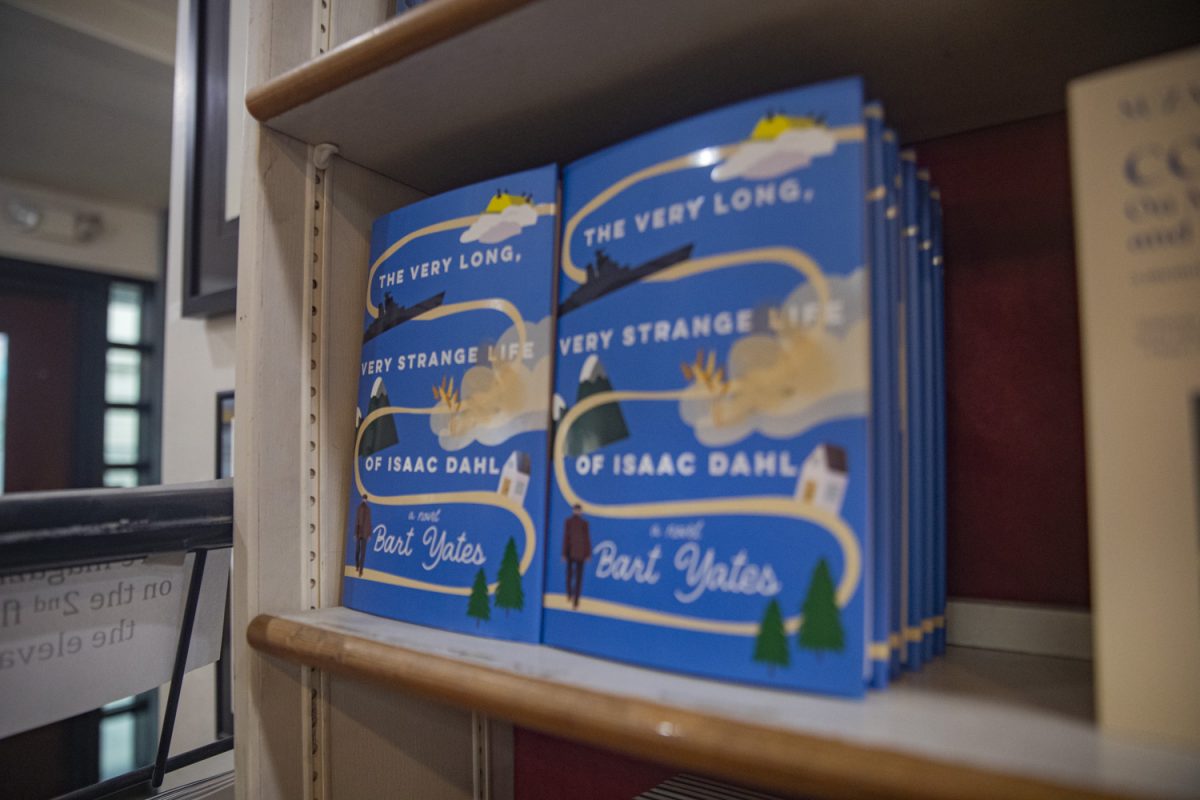Slow but steady wins the race.
Like countless other children, a young Valerie Beck heard these words of wisdom every time she and her sister finished Aesop’s fable “The Hare and the Tortoise.”
Even now, decades later, conjuring an image of the tale in her mind’s eye is easy for Beck. She’s brought that image to life in a tricolored, three-dimensional, handmade, sandblasted glass bowl.
A rabbit of pure yellow, a panicked look on his face, trails behind a deep-green turtle marked with yellow spots. Grass, identical in color to the turtle, dots the red landscape of the distance, making it appear as if the shrubbery grows in defiance of the sandy, scarlet soil. The feeling is magnified by the sky, clear in many places but tinted with just a bit of the blood-red.
The Iowa Artisan’s Gallery, 207 E. Washington St., is displaying and selling a collection of seven of the bowls Beck made, assisted by husband Rick Beck, all depicting fables she was told as a child. The pieces will be on display daily during regular business hours through July 6.
“Fables are very interesting to me, because if you look at different cultures, you see fables that are basically the same thing; they just have different characters or different animals but the same morals,” Valerie Beck said. “They’re very universal. Fables really give people an entrance into the work.”
Johnie McMahon, the manager of Iowa Artisans Gallery, noted the exhibit’s widespread appeal. Not even a full week after being put on display, one of the pieces had sold.
“A lot of children have really enjoyed looking at them and learning the fables and stories,” she said. “We thought this tied in really well with [Iowa City’s status as a] City of Literature.”
Though not at all connected to the Writers’ Workshop, Valerie Beck saw an appeal in presenting her work in Iowa City.
“If there were people [in Iowa City] who were familiar with literature and loved literature and grew up with these stories, it made sense to present them to them in a different medium,” she said.
To create these pieces, she first turned to Rick Beck, who has been working with glass since his days at Hastings College in 1978. Now living in North Carolina, the couple have their own small glass studio, and both continue to make their own pieces.
“My freshman year, my roommate grabbed me and took me [to the glass studio] as an assistant to him,” Rick Beck said. “It was hot, noisy, flamy, and immediate — and that’s everything an 18-year-old boy wants. Immediacy was the first hook, and as I learned the process and the skill set, that immediacy is long gone. There’s a very specific dance between you and this thing you’re working with that was unique; if you’re not moving your whole self, the whole piece is not happening.”
Very well-versed in dancing with glass after 36 years, Rick Beck began by creating shallow bowls of four layers — a clear coat and three colors.
Sounds simple enough, right? Wrong.
“Glass blowing is an additive process. The more you want, the more often you have to go back,” he said. “Glass in a hot state is molten, so you have to set something in there that the glass will stick to, in most cases a steel pipe. You have a window of 1,600 to 1,900 degrees to keep the glass in order to shape it.”
Layering the clear base and three colors on the pipe, he blows out the bowl. If done correctly, he said, the colors will spread out uniformly, creating four layers that gradually increase in thickness. He then shapes the mass into a shallow bowl so Valerie Beck will have access to every color.
“It’s kind of like if you took a plate and painted it with three colors,” he said. “You’ll see it a lot in woodwork, where they’ll paint three thick coats and then go back and sand off layers. Valerie will cut off a resist and sand blast around it, so that image will stay in the glass. So whereas glass-blowing is an additive process, the blasting is a subtractive process.”
The resists function as stencils; when stuck to the plate, the sand is not able to wear away layers below, so the topmost color remains. Without a resist, the top layer(s) are blasted away to reveal more colors underneath.
As Valerie Beck scoured through to the hidden colors, the bowls were given depth and texture. With The Lion and the Mouse, the sunshine yellow was kept to portray the animals but swept away to give them a red field on which to lie and a blotchy sky. Though created from only one layer of glass, the differences in temperature made the third layer, the sky, a swirling mix of pinks and purples with splashes of pale blue, jump out at the viewer. The image stands out in the collection comprising mostly solid, richer colors.
The detail is also enthralling. Tiny lines run through the sky, and small blades of grass are scattered throughout. On another piece, Peter and the Wolf, individual leaves and leaf markings on the background are subtly woven in, each one having to be meticulously made and placed perfectly for Valerie Beck’s sandblasting to give the ideal image.
The result, she said, is well worth the time and energy the bowls demand; a single piece can take upwards of 25 hours of work.
“It’s a very long process, but it gives me the finished pieces I like,” she said.
The nostalgia behind the pieces is also a big component of the art; they bring her back to her childhood.
“In Bible school as a kid, you got to listen to stories, sing songs, and do crafts. And one day I thought, ‘That’s kind of what I do now,’ ” she said. “I go out to the studio, and I sing songs and listen to stories or read stories and I do crafts; my life is like Bible school.”
ART






